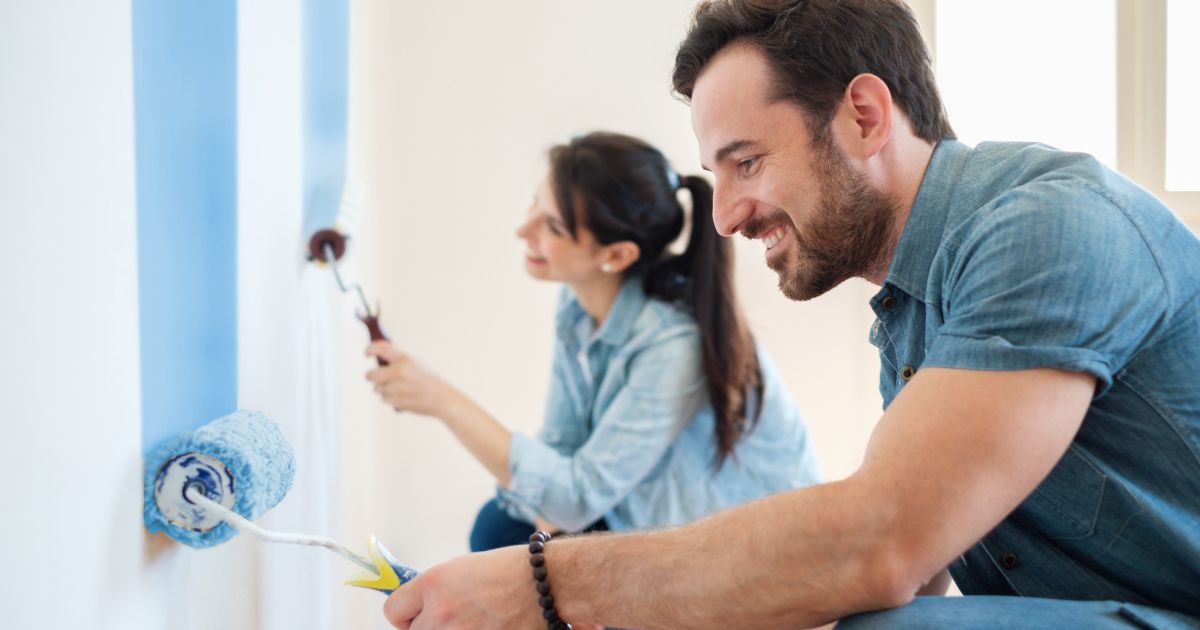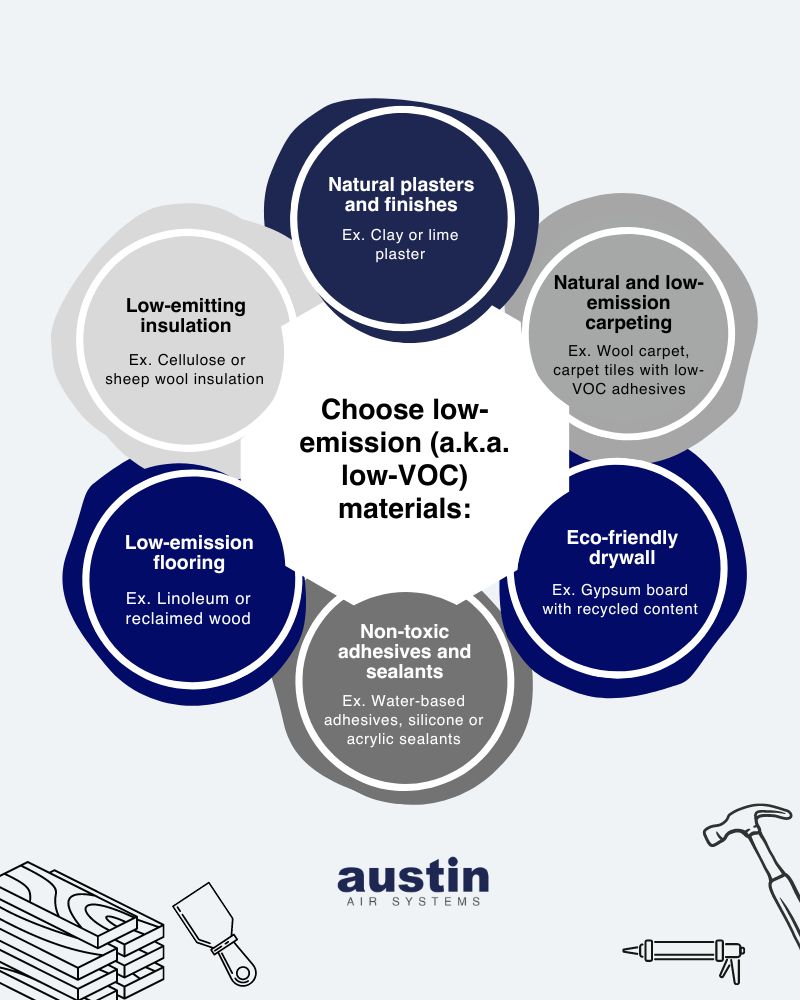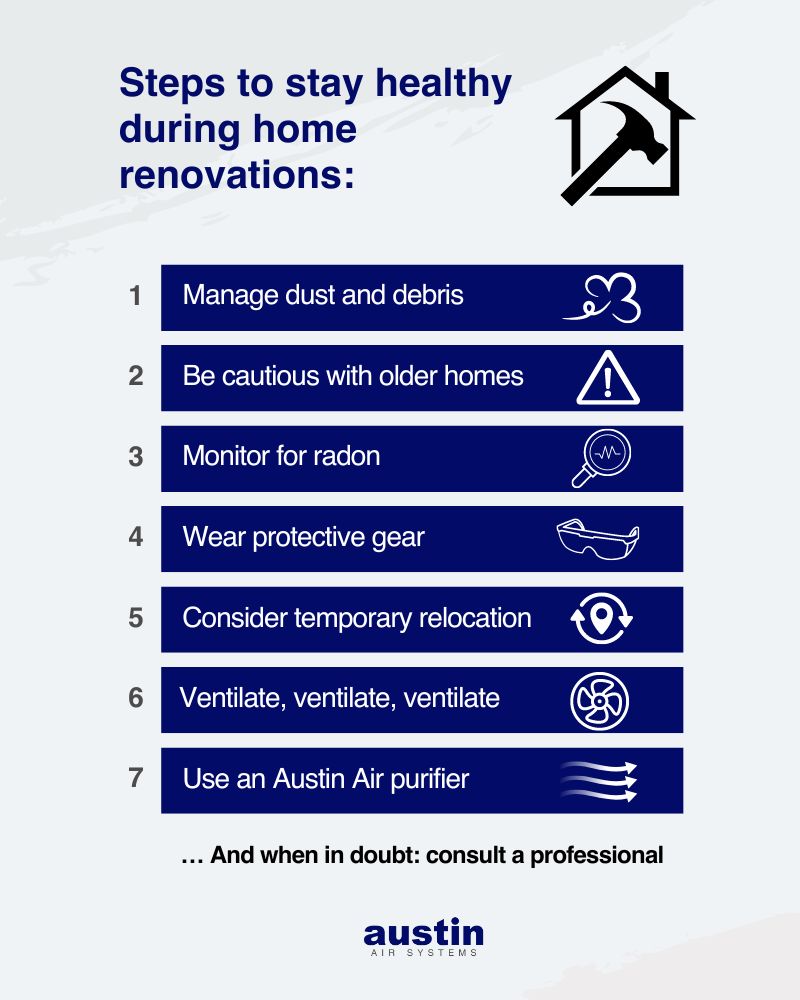As most DIYers know, spring and summer are prime seasons for tackling home renovation projects. Whether you’re dreaming of a fresh coat of paint, a new floor, or a complete room makeover, it’s essential to be mindful of your respiratory health during and after these activities.
Renovation work can generate dust, fumes, and other airborne particles that can affect your lungs including mold and other harmful substances. Here are some tips to ensure you breathe easy while improving your home and can enjoy it safely after the work is complete.1
Short-term Safety Measures Can Have Long-term Consequences
Even short-term exposure to high levels of dust, VOCs, and other pollutants during remodeling can cause acute respiratory issues. Using protective measures like dust barriers, air scrubbers, and personal protective equipment can reduce risks. So can safe practices, such as wet cutting to minimize dust and using low-emission products, helps protect both the person doing the work and the building occupants from respiratory hazards.
Choose Low-Emission Materials
When selecting materials for your renovation, opt for those that emit fewer volatile organic compounds (VOCs). VOCs are chemicals found in many building materials that can evaporate into the air at room temperature, potentially causing respiratory issues.
To start, look for paints, adhesives, and carpets that are labeled low-VOC or have an “asthma & allergy friendly” certification.
Here are some additional low-emission options:
- Low-Emitting Insulation
Cellulose Insulation: Made from recycled paper and treated with non-toxic fire retardants.
Sheep Wool Insulation: A natural, renewable, and biodegradable insulation option.
- Low-Emission Flooring
Linoleum: Made from natural materials like linseed oil, wood flour, and jute, it’s biodegradable and low-emitting but be careful about adhesives.
Reclaimed Wood: Reduces the need for new lumber and prevents old wood from going to waste.
- Non-Toxic Adhesives and Sealants
Water-Based Adhesives: Emit fewer VOCs compared to solvent-based adhesives.
Silicone and Acrylic Sealants: Generally emit lower levels of VOCs compared to other types of sealants.
- Eco-Friendly Drywall
Gypsum Board with Recycled Content: Contains recycled paper and synthetic gypsum, a byproduct of power plant emissions scrubbers.
- Natural and Low-Emission Carpeting
Wool Carpet: A natural and biodegradable option with low VOC emissions.
Carpet Tiles with Low-VOC Adhesives: Easier to replace in sections and often come with low-VOC backing and adhesives.
- Natural Plasters and Finishes
Clay Plaster: Made from natural earth materials, it’s non-toxic and helps regulate indoor humidity.
Lime Plaster: Has natural antimicrobial properties and is breathable, allowing moisture to escape from the walls.
By incorporating these materials into building projects, it’s possible to create healthier, more sustainable, and low-emission living and working environments.
Additional Steps For Respiratory Health
The building materials you use are hugely important but there are a range of other steps you can take to keep you and your loved ones safe during and after your home renovation project.
Manage Dust and Debris
Renovation projects often generate a significant amount of dust. To reduce dust buildup, seal off the work area from the rest of the house using plastic sheeting. Use a vacuum equipped with a HEPA filter to clean up dust and debris. Regularly damp mop floors and wipe down surfaces to prevent dust from becoming airborne.
Be Cautious with Older Homes
If your home was built before 1978, it might contain lead paint or asbestos. Lead paint is a serious health hazard, especially for children and pregnant women. Asbestos fibers, if disturbed, can cause lung diseases, including cancer.
If you live in an older home, don’t risk doing it yourself without being sure if it is safe first. It’s crucial to have a professional test for these substances before starting your renovation. If lead or asbestos is found, hire licensed professionals to handle and remove these materials safely.
Monitor for Radon
Radon is an odorless, colorless gas that can seep into homes from the ground and is a leading cause of lung cancer. Home renovations are an excellent opportunity to test for radon and take necessary mitigation steps if high levels are detected. Radon test kits are widely available and easy to use, providing peace of mind about this silent danger.
Wear Protective Gear
Wearing appropriate personal protective equipment (PPE) is a must during any renovation project. An N-95 rated mask can help block out 95% of small particles, including dust and mold spores. Safety goggles and gloves will protect your eyes and skin from irritants. If you’re dealing with chemicals or sanding materials, consider using a respirator for added respiratory protection.
Consider Temporary Relocation
If someone in your household has a pre-existing lung condition, such as asthma or COPD, it might be wise for them to stay elsewhere during the renovation. This precaution can help prevent exposure to dust and fumes that could exacerbate their condition. If temporary relocation isn’t possible, ensure they stay in a well-ventilated area away from the renovation zone.
Ventilation is Key
Proper ventilation is vital to minimize exposure to harmful fumes and dust. Open windows and doors whenever possible to ensure a steady flow of fresh air. Use exhaust fans and air purifiers to help remove airborne particles from the indoor environment. After completing your project, continue to ventilate the area for several days to allow any lingering fumes to dissipate.
Use an Austin Air Purifier
Yes, ventilation is crucial but using an Austin Air cleaner during and after home renovations is a smart choice for protecting your respiratory health.
Austin Air cleaners are equipped with an advanced filtration system that effectively captures harmful particles and chemicals, ensuring the air you breathe remains clean and safe. By running an Austin Air cleaner after the work is done, you can significantly reduce your exposure to any stubborn pollutants that remain after the renovation process, like VOCs off-gassing from paint and furniture.
Consult a Professional
When in doubt, seek advice from a professional contractor, especially if your renovation involves complex tasks or potential exposure to hazardous materials. Experienced contractors can offer valuable insights on maintaining a safe environment and may have suggestions for healthier alternatives.
*****************************
A healthy indoor environment contributes to overall well-being, comfort, and productivity. Good air quality can reduce the incidence of respiratory illnesses, improve sleep quality, and enhance the general health of occupants. Taking steps to ensure good indoor air quality is a proactive measure that can also prevent the development of respiratory conditions in the future.
By taking these precautions, you can significantly reduce the risk of respiratory issues during your home renovation projects. With mindful planning and the right protective measures, you can enjoy the transformation of your living space while keeping your lungs healthy and safe.
REFERENCE
1 Addressing Indoor Environmental Concerns During Remodeling. (2024, May 6). US EPA. https://www.epa.gov/indoor-air-quality-iaq/addressing-indoor-environmental-concerns-during-remodeling.


